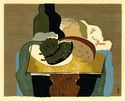
19th, 20th & 21st Century Fine Prints
707-546-7352 · fax 707-546-7924 · web: www.annexgalleries.com · email: artannex@aol.com
Konrad Cramer Biography
Konrad Cramer
American
1888–1963
Biography
Konrad Cramer was born in Wurtzburg, Germany, on November 9, 1888, and studied at the Karlsruhe Academy of Fine Arts from 1906 to 1908 with Ludwig Schmidt-Reutte and Ernest Schurth. After a year in the German army, he returned to Karlsruhe to set up a studio, making frequent trips to Munich, where he was exposed to the experimental artists of the Blaue Reiter group, including Wassily Kandinsky and Franz Marc. In 1911 Cramer met and married the American artist Florence Ballin who was traveling in Germany that year. The couple first traveled through Germany, visiting the exhibitions and studios of the country's avant-guard artists. Cramer then settled with his wife in Woodstock, New York, where Ballin had painted with the Art Students League each summer since 1906.
Konrad Cramer is often credited as being in important link between German and American modernism in art, and his experimentations with abstraction and expressionism during his first years in Woodstock would seem to bear this out. In 1912 and 1913, he painted a series he called "Improvisations" (after Kandinsky) which was shown in a group exhibition at the MacDowell Club in 1913 along with Andrew Dasburg, Oliver Chaffee, and Paul Rohland. Cramer was photographed by Alfred Stieglitz and wrote an essay about the 291 Gallery for Stieglitz's magazine, Camera Work, in 1914.
The Cramers had two daughters, in 1914 and 1917, and Konrad Cramer became an American citizen in 1917. For income, he began designing textiles for department stores using stencils and batiks around 1918. In his painting, he turned from abstract experiments to the traditional subjects of landscape, still life, and figure in a more representational style that blended modern and regional influences. Florence Ballin Cramer opened a gallery on 57th Street in 1919, encouraged by the sculptor Elie Nadelman. The mission of the Florence Gallery, as it was called, was to exhibit and sell the work of living artists. Although it only survived the season, it was the first gallery to show work by Yasuo Kuniyoshi, Alexander Brook, Ernest Fiene, and Stefan Hirsch, and generated important sales for several young artists in her circle.
Konrad Cramer returned to Europe in 1920 on a Rockefeller grant to study educational methods for craftsmen in Germany and France, and on his return he taught at the Woodstock School of Painting and Allied Arts. Cramer also studied lithography with Bolton Brown in Woodstock around this time, and both Cramers took up printmaking and began publishing prints in local arts magazines. The Cramers were deeply immersed in Woodstock life, participating in the annual Maverick festivals, the Woodstock Artists Association, the Historical Society, and other organizations, hosting meetings and serving as officers of many committees and organizations that presented and supported artwork in their community. They enjoyed a rich social life there among fellow artists at frequent parties and festivals, where Konrad provided entertainment with his fiddle and both Cramers memorialized events in countless photographs.
Konrad Cramer exhibited at the Whitney Studio Club in 1924, and taught at the Children's University School (now the Dalton School), where he painted a mural in 1929. The 1930s were busy years in both Cramers' professional lives. Konrad's exhibitions included the Carnegie International (1929 and 1933), and a two-man show at the Dudensing Gallery (1930), where Cramer and Adolph Gottlieb had been selected the most deserving unknown American painters of the year. He was also included in the exhibit Abstract Painting in America at the Whitney Museum (1935).
Konrad Cramer joined the Federal Art Project briefly in 1935, administering the regional program in Woodstock with Judson Smith. It was around this time that he began to learn photography. He became a sort of community photographer, taking photographs of friends' artwork and commissioned portraits, as well as informal photographs of friends. Cramer experimented with photographic techniques such as solarization and collage, using prisms, panes of glass, or composite printing. He first exhibited photographs in 1936 at the Albany Institute, and established the Woodstock School of Miniature Photography (the "miniature" referring to the then-new format of 35mm film) in 1937. He also taught courses in photography at Bard College in the 1940s, and his photographs and articles about photography were published in national magazines.
For the remainder of his life, Cramer continued to teach, write, and produce photographs, occasionally returning to painting, drawing, and printmaking, creating gouaches, wax resist drawings, and stencils of landscapes and figures, with an increasing interest in abstract styles and automatic techniques. Three of his early paintings were included in the 1946 Whitney Museum exhibition Pioneers of Modern Art in America, and the same year, he exhibited abstract photographs at the Woodstock Artists Association. In the late 1940s, he built an automatic drawing machine which he called the sympalmagraph, which rendered precise, geometric forms. In the late 1950s, he collaborated on a traveling exhibition and book of abstract photographs with Manuel Komroff and Nathan Resnik called The Third Eye.
Konrad Cramer died on January 28, 1963 in Woodstock, New York. Both he and Florence Ballin were memorialized in an exhibition at the Woodstock Artists Association Gallery in 1968.
Biography drawn in part from Archive of American Art and other sources.

